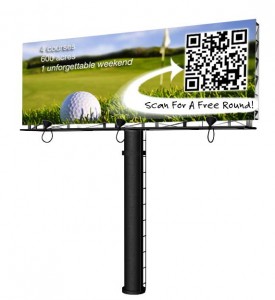Understand How QR Codes, Near-Field and Crowdsourcing Technology Work With Outdoor Advertising
Outdoor advertising has always benefitted from the development of new technologies. Just when you think it has advanced as far as possible, something new is just around the corner! With the invention of the smart phone, outdoor now has the ability to become more interactive, social and viral.
Some of the new technologies available to incorporate into outdoor advertising campaigns are Quick Response (QR) codes, Near Field Communication (NFC) and Wisdom of the Crowd technologies. These campaigns can be effective if used correctly.
Some important things to keep in mind: Remember that the percentage of adults in the US who actually have smart phones is still rather small. The number of people who have a QR Code app downloaded is even smaller. Also note that owners of NFC-enabled phones are a small population in the US as well.
Quick Response (QR) Codes
In June 2011, 14 million Americans, or 6.2% of all mobile users, scanned a QR Code with their devices. Those who scanned QR codes were more likely to be male (60.5%), between ages 18-34 (53.4%), and have a household income of $100k or higher (36.1%), according to comScore.
The best uses for QR Codes are for calls-to-action and coupon or offer downloading. QR Codes are a great way to help build your email list if you provide email opt-ins on the landing pages. One key point is to make sure that the QR Code isn’t directing the consumer to the company’s main homepage. The landing page should be something that will excite prospects and not bore or disappoint them. Think of ways to make the process fun, such as by providing a QR Code scavenger hunt. Give the consumer a reason to come back.
The best places for QR Codes are in high pedestrian areas. For obvious reasons, they should not be placed in billboard creative unless the location happens to be in a parking lot or side of a building. Also keep in mind the height of the ad and the time the consumers need to be able to pull out their smart phones and click the picture. The Outdoor Advertising Association of America (OAAA) has established some guidelines for using QR Codes. For instance a good rule of thumb is that a board shouldn’t be any higher than 20 feet off the ground.
Placement in the ad is also critical. If a bus shelter design has a QR Code in the lower right hand corner, the pedestrian may have to get down on his knees to properly scan the code. Always test your creative when using new technology. Also, take into consideration the environment.
Near-Field Communication (NFC) technology
There has been a lot of information lately about NFC technology. NFC allows for the transfer of data between compatible devices simply by placing them near each other (within four centimeters).
Some of the ways NFC is being used:
- Airline ticketing/boarding passes
- Sharing files between phones
- Using your phone as a credit card
- Getting information by touching smart posters
- Brand Loyalty cards
Imagine buying products right off of a bus shelter. Many of the same creative guidelines that apply to QR Codes also apply for Smart Posters (NFC-enabled). However, there is a little more flexibility in that the consumer doesn’t have to take the time to snap a picture or find the NFC label in the lens. The consumer just has to be within the 4 centimeters to enable the technology.
Adoption of NFC technology may take a bit longer due to available technology, education and production costs of Smart Posters. QR Codes add virtually no cost to the production budget. But Smart Posters might be a little more prohibitive.
Wisdom of the Crowd Technologies
Does the crowd know best? Sometimes. Retailers have started using digital billboards, shelters and placed-based media to sell popular items, as well as items that aren’t selling. Stores can now communicate items and pricing with the public based on the inventory that is currently selling.
For instance, if a retailer has merchandise that is a ‘€œhot’€ seller, and they run out of stock, they can quickly change the digital creative to another item and price point. Also, if an interesting ‘€œconversation’€ is trending on their Facebook page, they can opt to change their creative to tie into what interests their customers. These campaigns are easy to implement with social media, inventory visibility and the flexibility of Internet technology.
Before initiating any interactive OOH campaign, do your research. There are many studies and associations available for most of these technologies. Not only does OAAA have many Interactive OOH case studies available on their website, but they also just released an Interactive OOH Primer. Contact Monisha Blair at OAAA at 202-833-5566 for more information.
If you have implemented an interactive campaign using these technologies, please send them to us to post on our site. We have over 450 agencies using our site as an information source.





